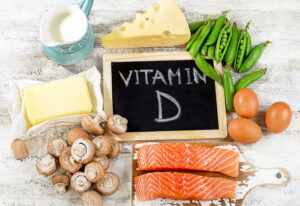A recent study showed supplementing with Vitamin D could reduce your risk of developing advanced cancer.
This discovery came from the Vitamin D and Omega-3 Trial (VITAL), a study published two years ago. VITAL looked at the benefits of vitamin D and omega-3 fatty acids for cancer and heart disease among 25,871 American men (50 and older) and women (55 and older).
 All of them were cancer-free at the beginning of the study. Participants were randomly assigned to daily take either:
All of them were cancer-free at the beginning of the study. Participants were randomly assigned to daily take either:
- 2,000 international units (IUs) of vitamin D and one gram of omega-3 fatty acids
- A placebo
Over an intervention period averaging about five years, 1,617 of these participants were diagnosed with an invasive cancer.
When researchers recently went back at the VITAL study, they found something interesting: Those who took a vitamin D supplement were about 20 percent less likely to develop advanced cancer than those who took a placebo.[1]
That finding encouraged researchers to re-evaluate the VITAL study, with a specific focus on vitamin D.
3 Take-Home Findings About Vitamin D
The VITAL study supports the philosophy at MaxLiving that the body has an amazing ability to heal itself when you remove what interferes with health and provide the right support.
Three important conclusions researchers made when they looked at the VITAL study again:
- Vitamin D supplements didn’t prevent cancer. Instead, vitamin D may help reduce the risk of cancer spreading or dying from cancer.
- A healthy weight matters. Only participants with a normal body mass index (BMI) – a measure of body fat to determine a healthy weight – benefited from vitamin D supplements. Why didn’t overweight or obese people get those benefits? Researchers believed their bodies may not be utilizing vitamin D as effectively, even at higher doses. [2]
- Maintaining healthy vitamin D levels is critical. People with an increased risk for cancer – say, if cancer runs in your family – should be careful to avoid vitamin D deficiencies. This echoes earlier studies, which show a link between low vitamin D levels and a higher risk of cancer. [3]
COVID Highlights the Dangers of Vitamin D Deficiencies
About 42 percent of Americans are deficient in vitamin D. For some populations, such as older people and people with darker skin, that percentage is even higher. [4]
Studies show vitamin D deficiencies can increase the risk of many conditions, including:
- Cancer
- Heart disease
- Diabetes
- Autoimmune diseases
- Depression [5]
More recently, researchers found 80 percent of COVID-19 patients at a Spanish hospital had low levels of vitamin D. [6] On the other hand, studies show higher levels of vitamin D may reduce the severity of COVID-19. [7]
5 Ways to Improve Vitamin D Levels
Keeping vitamin D levels on a healthy level is critical for overall health. Numerous studies have shown that vItamin D can reduce the risk of several types of cancer, respiratory and other types of infections, and many other conditions. [8]
Fortunately, you have several ways to maintain optimal levels of vitamin D:
1. Test, don’t guess.
A 25-hydroxy vitamin D test is the most accurate way to know what your vitamin D levels are. [9] Your healthcare practitioner can test your levels with a blood test. You can also test at home. Experts recommend your vitamin D levels should be between 20 and 40 ng/mL, although others recommend up to 50 ng/mL. [10] If you have low levels, work with your healthcare practitioner to find and maintain your ideal level.
2. Eat more vitamin D-rich foods.

Fatty fish and egg yolks are especially high in vitamin D. Wild-caught salmon is a great choice. [11] Our Herb Butter Salmon and Asparagus makes a tasty way to get this vitamin D-rich food.
3. Find your healthy weight.
Overweight and obese people often have lower vitamin D levels.[12] Keeping an ideal weight can improve vitamin D levels. A keto diet, with a focus on vitamin D-rich foods such as fatty fish, is ideal to lose weight and keep it off. Learn more about keto diets and why they work here.
4. Get some sun exposure.
Your skin can make vitamin D from the sun’s rays. About 10 to 15 minutes of sun on exposed, unprotected skin is enough to make vitamin D. Some barriers can prevent that from happening, including:
- The time of day
- Where you live
- Your age
- Your skin color
- Sunscreen [13]
5. Take a vitamin D supplement.
Research strongly supports supplementing with vitamin D, especially in high-risk populations such as the elderly. [14] Some experts believe that everyone should consider taking a daily supplement.
Not All Vitamin D Supplements Make the Grade
- Some contain vitamin D2 (ergocalciferol), which is not as well-absorbed as vitamin D3 (cholecalciferol). [15]
- Some only have the recommended dietary allowance (RDA) of vitamin D, which researchers feel may be too low. [16]
- Some contain poor-quality ingredients, such as soybean oil.
The ultimate vitamin D product combines therapeutic amounts of vitamin D with other nutrients that enhance its benefits.
One of them is probiotics. These live bacteria support gut health, prevent vitamin D deficiencies, and enhance vitamin D absorption. So can prebiotics, the “food” that probiotics thrive on. [17] Learn more about prebiotics and probiotics in this article.
 We’ve formulated our Vitamin D3 + Probiotics to be the ultimate vitamin D supplement. Each capsule provides:
We’ve formulated our Vitamin D3 + Probiotics to be the ultimate vitamin D supplement. Each capsule provides:
- 5,000 IUs of vitamin D3
- 10 Billion CFU of probiotics
- Prebiotic fructo-oligsaccharides (FOS) from chicory root
Vitamin D3 + Probiotics is the highest-quality vitamin D product on the market, providing therapeutic amounts of vitamin D along with probiotics and prebiotics. Always take vitamin D with a meal containing fat for optimal absorption.
About the Author
 Jason Boehm is a Chicago, IL-based nutritionist and science writer. He combines his two Master’s Degrees in Mass Communication and Nutrition to help others achieve their wellness goals through science-based, engaging written content.
Jason Boehm is a Chicago, IL-based nutritionist and science writer. He combines his two Master’s Degrees in Mass Communication and Nutrition to help others achieve their wellness goals through science-based, engaging written content.
References
[1] https://jamanetwork.com/journals/jamanetworkopen/fullarticle/2773074
[2] https://www.health.harvard.edu/staying-healthy/vitamin-d-supplements-linked-to-lower-risk-of-advanced-cancer
[3] https://www.ncbi.nlm.nih.gov/pmc/articles/PMC3356951/
[4] https://www.cantonmercy.org/healthchat/42-percent-of-americans-are-vitamin-d-deficient/
[5] https://www.ncbi.nlm.nih.gov/books/NBK532266/
[6] https://www.sciencedaily.com/releases/2020/10/201027092216.htm
[7] https://www.ncbi.nlm.nih.gov/pmc/articles/PMC7385774/
[8] https://www.ncbi.nlm.nih.gov/pmc/articles/PMC3761874/
[9] https://medlineplus.gov/ency/article/003569.htm
[10] https://medlineplus.gov/ency/article/003569.htm
[11] https://pubmed.ncbi.nlm.nih.gov/31036792/#
[12] https://www.ncbi.nlm.nih.gov/pmc/articles/PMC6532760/
[13] https://www.health.harvard.edu/staying-healthy/time-for-more-vitamin-d
[14] https://pubmed.ncbi.nlm.nih.gov/33525447/
[15] https://pubmed.ncbi.nlm.nih.gov/24001747/


